How Microgreens Help Detoxify the Body
Microgreens are not merely trendy garnishes; they deliver a remarkable nutritional boost that supports your body s detoxification process, making them important for healthy eating.
This article delves into the world of microgreens, exploring their various types and the impressive benefits they offer for organ health. From delightful recipes to straightforward growing tips, you ll discover fun ways to add microgreens into your meals, enhancing your dishes with their unique flavor and health benefits.
Potential side effects are also discussed, ensuring that your microgreen journey remains safe and enjoyable.
Dive in to discover how these miniature powerhouses can elevate your well-being!
Contents
- Key Takeaways:
- What are Microgreens?
- Benefits of Microgreens for Detoxification
- How to Incorporate Microgreens into Your Diet
- Tips for Growing Your Own Microgreens
- Potential Side Effects and Precautions
- Frequently Asked Questions
- How do microgreens help detoxify the body and support overall health?
- Which microgreens are best for detoxification?
- How do I incorporate microgreens into my detox routine?
- What are the benefits of detoxifying the body with microgreens?
- How often should I consume microgreens for detoxification?
- Are there any side effects of using microgreens for detoxification?
Key Takeaways:

- Try adding various microgreens to your meals for better health!
- Microgreens are rich in vitamins, minerals, and antioxidants that support the body’s natural detoxification processes, helping with cancer prevention and heart disease management.
- Did you know that growing microgreens at home is simple and fun? It guarantees you ll always have fresh greens on hand!
What are Microgreens?
Microgreens are young, edible plants harvested just after their first true leaves emerge. They come in a delightful array of flavors, colors, and textures that have captivated health-conscious diners.
Often hailed as a superfood, these petite greens are brimming with concentrated nutrients, providing a simple yet effective way to elevate the nutritional profile of your meals.
Sourced from diverse vegetable families, including the Brassicaceae, microgreens offer substantial health benefits that can enrich your diet in remarkable ways.
Definition and Types of Microgreens
Microgreens are essentially miniature versions of edible plants, harvested just after the first true leaves appear. They come in a dazzling array of varieties, including beloved types like broccoli, fenugreek, spinach, and cilantro.
These tiny greens not only catch the eye but also deliver a punch of flavor and nutrients. For instance, arugula microgreens bring a peppery kick that elevates your salads and sandwiches, while beet greens add an earthy sweetness, making them a fantastic choice for smoothies or garnishes. Their nutrient profiles are rich in concentrated nutrients like vitamin C and iron, enhancing your overall health. To learn more about their health benefits, check out the science behind microgreens and health. Radish microgreens, on the other hand, offer a zesty bite that perfectly complements seafood dishes.
Their versatility is unmatched; you can sprinkle them on grain bowls, whip them into pesto, or roll them up in fresh spring rolls. Beyond their culinary charm, these microgreens are packed with health benefits, brimming with vitamins and antioxidants that attract both gourmet chefs and health-conscious individuals. For more on their incredible properties, check out unlocking the antioxidant power of microgreens.
Benefits of Microgreens for Detoxification
Microgreens provide an array of health benefits, particularly for detoxification support, which is the process of removing toxins from the body. Their abundant antioxidants and phytonutrients natural compounds in plants work together to help your body neutralize environmental toxins and enhance its detoxification pathways.
Embracing these vibrant greens can be a powerful addition to your wellness routine.
Nutritional Value and Detox Properties

Get ready to discover the incredible health benefits of microgreens! They re packed with concentrated nutrients, offering impressive levels of vitamin C, polyphenols, and glucosinolates. These elements enhance their detoxification properties and overall nutritional value.
Harvested just after germination, microgreens often contain five to ten times more nutrients than their mature counterparts. This includes dietary fiber and antioxidants, making them a true health powerhouse. Their abundant vitamin C content is essential for boosting your immune system, while polyphenols provide robust antioxidant protection against oxidative stress. Incorporating these greens into your diet allows you to experience the benefits of eating microgreens daily.
Glucosinolates are compounds found in some vegetables that help detoxify the body. These compounds, commonly found in cruciferous vegetables, support detoxification and enhance liver function, promoting cellular health. By incorporating microgreens into your diet, you can elevate your nutrient intake and boost your wellness, all while enjoying a burst of flavor. For more information on their health benefits, check out the health benefits of microgreens explained, including essential vitamins like E and K.
Specific Benefits for Different Organs
The advantages of microgreens extend to various organs, providing crucial detoxification support. They can elevate your blood health, enhance your digestive health, and fortify your immune system. These tiny greens are not just cute; they are packed with essential vitamins and minerals that promote liver health by aiding the detoxification process essential for eliminating harmful substances from your body.
Their high fiber content supports your digestive system, promoting regularity and optimizing nutrient absorption, leading to a healthier gut. Microgreens deliver powerful antioxidants that combat oxidative stress, boosting your body’s defenses against illnesses. For more insights on how these greens benefit your health, check out how microgreens support immune health. Integrating these nutrient-dense greens into your meals can enhance overall organ function and vitality while helping to manage blood sugar levels and insulin resistance.
How to Incorporate Microgreens into Your Diet
Incorporating microgreens into your diet is a delightful and nutritious choice that elevates your meals. You can sprinkle them onto salads, layer them in sandwiches, blend them into smoothies, or use them in various cooking methods. These tiny greens offer an abundance of flavor and health benefits.
Recipes and Meal Ideas
Microgreens can effortlessly elevate a variety of recipes, transforming everything from fresh salads to nutrient-packed smoothies. They enhance both the flavor and the nutritional profile of your meals, making them a part of a balanced diet.
These tiny powerhouses are vibrant and visually appealing while delivering a significant dose of essential vitamins, minerals, and antioxidants. Picture a colorful microgreens salad adorned with radish and basil microgreens, instantly elevating your simple mixed greens to something extraordinary while adding delightful crunch. For those interested in health benefits, explore the impact of microgreens on overall wellbeing.
Consider blending sunflower microgreens into your smoothie for a creamy texture and a boost of vitamins C and E. Their versatility shines as they make ideal garnishes for soups, toppings for sandwiches, or even ingredients in pasta dishes. Incorporate these nutritious greens into your daily diet, enhancing your culinary creations with minimal effort and supporting a healthy lifestyle. For more information, learn why microgreens are essential for a balanced diet.
Tips for Growing Your Own Microgreens

Growing your own microgreens at home can be an incredibly rewarding experience. It doesn’t require much in terms of supplies, and the techniques are straightforward.
This makes it an accessible venture for anyone looking to elevate their health and culinary skills.
Don’t miss out on the chance to grow these nutrient powerhouses! Start your microgreens garden today!
Supplies and Techniques for Growing at Home
To successfully cultivate microgreens at home, you ll need some essential supplies trays, soil, and seeds. You ll also need techniques that foster optimal growth and nutrient retention.
Selecting the right variety of seeds is critical. Each type brings its own unique flavors and health benefits, particularly from a family of plants that includes broccoli, kale, and cabbage. Using high-quality soil that offers excellent drainage and aeration will significantly enhance how well your seeds sprout.
Using techniques like watering from the bottom of the tray promotes strong roots and reduces the risk of mold. This creates a thriving environment for your plants.
Light is another crucial element. Whether you opt for natural sunlight or grow lights, providing 12-16 hours of light per day can dramatically accelerate growth and improve the antioxidant properties of your microgreens.
Keep a close eye on moisture levels and ensure proper air circulation. These fundamental practices are key to your success in growing microgreens.
Potential Side Effects and Precautions
Be aware of potential side effects and foodborne risks, especially if you belong to vulnerable groups, such as those with a compromised immune system or certain health conditions.
When to Avoid Microgreens or Seek Medical Advice
Certain individuals may need to think twice before diving into the world of microgreens or consider consulting a healthcare professional. This is especially true if they have specific health conditions or weakened immune systems that could pose potential risks.
If you’re someone with a compromised immune system like those undergoing chemotherapy or living with HIV/AIDS it s wise to be cautious. The risk of foodborne illness may be elevated.
If you’re dealing with kidney-related issues, be aware that some microgreens can pack a high potassium punch, which could compound issues related to blood health. Additionally, if you’re pregnant, you might want to limit your consumption of raw greens, including microgreens, due to the potential presence of harmful bacteria. For more information on how microgreens can contribute to your diet, check out the role of microgreens in healthy eating.
For anyone in these categories, consulting with a healthcare provider before incorporating microgreens into your diet is essential. This ensures your meals remain both safe and nutritious, aligning with your health goals.
Frequently Asked Questions

How do microgreens help detoxify the body and support overall health?
Microgreens contain high levels of antioxidants, including vitamins C and E. These help eliminate toxins and free radicals from the body, promoting detoxification support.
Which microgreens are best for detoxification?
Some of the best microgreens for detoxification include wheatgrass, broccoli, kale, and cilantro. They are rich in detoxifying compounds and phytonutrients.
How do I incorporate microgreens into my detox routine?
Add microgreens to your detox smoothies, salads, or use them as a garnish or side dish. Make them a part of your health-conscious eating routine.
What are the benefits of detoxifying the body with microgreens?
Detoxifying with microgreens can boost your immune system, improve digestion and gastrointestinal health, and increase energy levels due to their concentrated nutrients.
How often should I consume microgreens for detoxification?
It is recommended to consume microgreens daily for optimal detoxification benefits. Start with small amounts and gradually increase as desired.
Are there any side effects of using microgreens for detoxification?
As long as you are not allergic to the specific microgreens you are consuming, there are no known side effects to using them for detoxification. However, it is always best to consult with a healthcare professional before making significant changes to your diet, especially if you have concerns about conditions like Type 2 diabetes or iron deficiency.
Start growing your microgreens today to enjoy fresh, nutrient-packed greens! Share your experiences with microgreens or subscribe for more tips on healthy eating.






